Historical Monuments
There are magnificent monuments in the citadel of Alanya, which is the nominee for Unesco Cultural Heritage of the world. Along with the monuments such as the walls, Kızılkule, the dockyard and the gun house, old houses of Alanya inhabited after having been restored are also protected and they are worth visiting. In some of the houses weaving is continued with old looms and meal is served in their gardens. If you look carefully at the citadel, a heritage from the medieval times, while visiting, you will notice some stone carvings dating back to the antiquity. Visiting the citadel of Alanya in details may take you a whole day. There are many caravanserais and fortresses to protect them, nearby since Alanya was a city on the route of the historical Silk Road.
The Citadel of Alanya
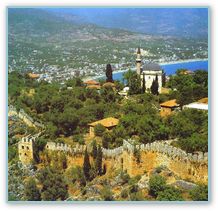 The Citadel of Alanya, the walls of which are nearly 6.5 kilometres long, is on a peninsula whose height is up to 250 metres from the sea level. Although the settlement on Alanya peninsula, also known as Kandeleri, dates back to the Hellenistic Era, its cultural characteristics that can be seen today are thanks to Selcuks of the 13th century. The citadel was constructed on the demand of the Sultan of Selcuks, Alaaddin Keykubat, who conquered and had the city rebuilt in 1221. The citadel has 83 towers and 140 bastions. Nearly 400 cisterns were built to supply the city surrounded by walks in the medieval times with water. Some of the cisterns are still used today. The walls were built in a well-planned manner; downwards to Ehmedek, İçkale, Adama Atacağı, the upper part of Cilvarda Bay, Arap Evliyası Burcu and Esat Burcu, then through the gun house and the dockyard and they end up in Kızılkule-İçkale, an open-air museum, is located at the peak of the peninsula. Alaaddin Keykubat, the Sultan, had his palace built there. Today the citadel is still inhabited by people. In front of wooden and brick houses of historical value, silk and cotton are woven, white gourds are painted in different figures and authentic meals are served in small gardens. There are also restaurants and cafés on the way to the citadel and on its sides overlooking the harbour. The citadel is open to traffic. It takes you nearly an hour to walk to the citadel.
The Citadel of Alanya, the walls of which are nearly 6.5 kilometres long, is on a peninsula whose height is up to 250 metres from the sea level. Although the settlement on Alanya peninsula, also known as Kandeleri, dates back to the Hellenistic Era, its cultural characteristics that can be seen today are thanks to Selcuks of the 13th century. The citadel was constructed on the demand of the Sultan of Selcuks, Alaaddin Keykubat, who conquered and had the city rebuilt in 1221. The citadel has 83 towers and 140 bastions. Nearly 400 cisterns were built to supply the city surrounded by walks in the medieval times with water. Some of the cisterns are still used today. The walls were built in a well-planned manner; downwards to Ehmedek, İçkale, Adama Atacağı, the upper part of Cilvarda Bay, Arap Evliyası Burcu and Esat Burcu, then through the gun house and the dockyard and they end up in Kızılkule-İçkale, an open-air museum, is located at the peak of the peninsula. Alaaddin Keykubat, the Sultan, had his palace built there. Today the citadel is still inhabited by people. In front of wooden and brick houses of historical value, silk and cotton are woven, white gourds are painted in different figures and authentic meals are served in small gardens. There are also restaurants and cafés on the way to the citadel and on its sides overlooking the harbour. The citadel is open to traffic. It takes you nearly an hour to walk to the citadel.
Red Tower
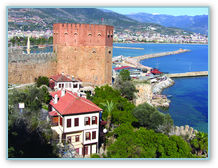 It's in the harbour. The octagonal shaped building that's the symbol of the city is a work by Selcuks of the 13th century. It was built in 1226 by Ebu Ali Rehç el Kettani, a master builder from Aleppo and had built the citadel of Sinop before on the demand of Alaaddin Keykubat, the Sultan of Selcuks. It was made of red bricks, the upper parts of which had been fired, since stone blocks were difficult to lift at a certain height, thus it was given the name of Kızılkule (Red Tower).
It's in the harbour. The octagonal shaped building that's the symbol of the city is a work by Selcuks of the 13th century. It was built in 1226 by Ebu Ali Rehç el Kettani, a master builder from Aleppo and had built the citadel of Sinop before on the demand of Alaaddin Keykubat, the Sultan of Selcuks. It was made of red bricks, the upper parts of which had been fired, since stone blocks were difficult to lift at a certain height, thus it was given the name of Kızılkule (Red Tower).
Marble blocks of the antiquity are seen in the walls of the citadel. The height of the tower that is octagonal in shape is 33 meters and it is 29 meters in diameter, its each wall is 12.5 metres long. There are five floors, including the ground floor. You can go to the top of the tower with the help of stone stairs that are high-spaced and have 85 steps. Sunlight coming from the top of the tower even reaches the first floor. There is a cistern in the middle of the tower. The tower was built in order to protect the harbour and the dockyard from naval attacks and was used for military purposes for centuries. Being restored in 1950s, the tower was opened to visitors in 1979, and its first floor began to be used as the museum of Ethnography.
The Dockyard
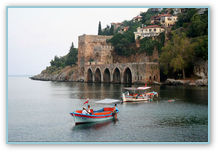 Its construction started in 1227, six years later than the Sultan's conquest of the city, near Kızılkule and finished in one year. The Side of the dockyard overlooking the sea and having five cells with arches is 56.5 metres long and it is 44 metres in depth. The area selected for the dockyard was planned to have the most sunlight. The statement on the front door of the dockyard has the Sultan Keykubat's armorial bearings and is decorated with badges. The dockyard of Alanya was the first one of Selcuks in the Mediterranean, Alaaddin Keykubat, who had the dockyard of Sinop built before, was given the little of "the Sultan of the two seas" with the opening of the dockyard of Alanya. On one side of the dockyard there is a small mosque, and a guard room on the other. There is a well that has dried up in time in one of the cells. You can go to the dockyard by boats or on foot passing the walls near Kızılkule and can enter the dockyard without any payments
Its construction started in 1227, six years later than the Sultan's conquest of the city, near Kızılkule and finished in one year. The Side of the dockyard overlooking the sea and having five cells with arches is 56.5 metres long and it is 44 metres in depth. The area selected for the dockyard was planned to have the most sunlight. The statement on the front door of the dockyard has the Sultan Keykubat's armorial bearings and is decorated with badges. The dockyard of Alanya was the first one of Selcuks in the Mediterranean, Alaaddin Keykubat, who had the dockyard of Sinop built before, was given the little of "the Sultan of the two seas" with the opening of the dockyard of Alanya. On one side of the dockyard there is a small mosque, and a guard room on the other. There is a well that has dried up in time in one of the cells. You can go to the dockyard by boats or on foot passing the walls near Kızılkule and can enter the dockyard without any payments
Bedesten
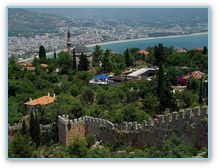 It's in the citadel, near Sülaymaniye Mosque. It's thought to have been be built in the 14th or the 15th century during the Karamanoğulları period as a bazaar or an inn. It's a rectangular building made of stone blocks. It has 26 rooms and a courtyard that is 35 metres long and 13 metres wide. Today this historical building is used as a hotel, a restaurant and a cafe. The shops of the medieval times, overlooking the courtyard are now redesigned as hotel rooms. There's a big cistern at the end of the stairs in the garden. The garden overlooks the above walls on one side, and the Taurus Mountains, the Mediterranean and the beach on the other side. Bedesten can be visited with the permission of the person who runs it.
It's in the citadel, near Sülaymaniye Mosque. It's thought to have been be built in the 14th or the 15th century during the Karamanoğulları period as a bazaar or an inn. It's a rectangular building made of stone blocks. It has 26 rooms and a courtyard that is 35 metres long and 13 metres wide. Today this historical building is used as a hotel, a restaurant and a cafe. The shops of the medieval times, overlooking the courtyard are now redesigned as hotel rooms. There's a big cistern at the end of the stairs in the garden. The garden overlooks the above walls on one side, and the Taurus Mountains, the Mediterranean and the beach on the other side. Bedesten can be visited with the permission of the person who runs it.
The Citadel Of Alara
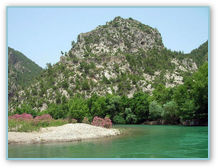 The Citadel of Alara was built in 1232, 37 kilometres westward from Alanya on the demand of Alaaddin Keykubat, the Sultan of Selcuks and it is 9 kilometres far from the sea. The aim of the citadel that was on the Silk Road was to protect the crowds stopped at the inn near the Alara creek. It's built on a steep hill of 200 meters up to 500. It looks magnificent. It consists of an inner and outer part. A dark entrance-hall of 120 steps enters the citadel. It is important to be careful about the wild plants and ruins, since it is not organized as a place to be visited. There are tunnels made by carving rock in the citadel. There is a small palace, the rooms of the workers, a mosque and a Turkish bath in the ruins. Those who would like to go to the top of the citadel through the walls and paths have to climb at least one hour and be equipped properly. However, the view from the top is worth climbing.
The Citadel of Alara was built in 1232, 37 kilometres westward from Alanya on the demand of Alaaddin Keykubat, the Sultan of Selcuks and it is 9 kilometres far from the sea. The aim of the citadel that was on the Silk Road was to protect the crowds stopped at the inn near the Alara creek. It's built on a steep hill of 200 meters up to 500. It looks magnificent. It consists of an inner and outer part. A dark entrance-hall of 120 steps enters the citadel. It is important to be careful about the wild plants and ruins, since it is not organized as a place to be visited. There are tunnels made by carving rock in the citadel. There is a small palace, the rooms of the workers, a mosque and a Turkish bath in the ruins. Those who would like to go to the top of the citadel through the walls and paths have to climb at least one hour and be equipped properly. However, the view from the top is worth climbing.
Antique Cities
There are a lot of remnants of ancient cities through the east and west axis of Alanya. The cities some of which founded in the coast and some founded in steep slopes are called Pamphylia and Kilikia region cities. The remnants reflect the Characteristic features of these regions. The stone ash boxes exhibited in Alanya Archaeological Museum reflect the way of burying the dead in Kilikya region. Entrance to these sites which are being protected and where in some parts still excavations are being carried out, is free. Considering the long walks through stony and bushy footpath, people who would like to visit ruins should choose appropriate shoes and carry some water on summer days.
Hamaxia
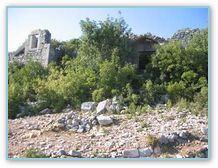 It is 12 kilometres far from Alanya. Within the borders of Pamphylia Region. Strabon, the eminent geographer of the antiqity, mentions that the timber used in ship building was grown in the town and particularly there were cedar trees in the town. It is believed that the town was founded before Roman period. Rectangular stone shaped tower shows Hellenistic features. The most important ruins of the town include; an antique fountain. Pool, semicircle designed, excedra whose seat are still seen still readable inscriptions, religious complex and necropolis. Some inscriptions discovered in the town pave emblem of Hermes which indicates existence of Hermes temple in the town. Considerable parts of an embossed otel Ostoteks exhibited in the Alanya Museum were discovered in the town. It is known that a small community not being rich lived in Hamaxia between A.D. 100 and 200 under reign of Coracesium. Important part of the ruins are dated from Roman and Byzantine Period. It is free to visit this site. It has a nice view of Alanya from he slope that faces the sea. When there is no mist, it is possible to see that coast which is more than 100 km between Gazipaşa and Manavgat.
It is 12 kilometres far from Alanya. Within the borders of Pamphylia Region. Strabon, the eminent geographer of the antiqity, mentions that the timber used in ship building was grown in the town and particularly there were cedar trees in the town. It is believed that the town was founded before Roman period. Rectangular stone shaped tower shows Hellenistic features. The most important ruins of the town include; an antique fountain. Pool, semicircle designed, excedra whose seat are still seen still readable inscriptions, religious complex and necropolis. Some inscriptions discovered in the town pave emblem of Hermes which indicates existence of Hermes temple in the town. Considerable parts of an embossed otel Ostoteks exhibited in the Alanya Museum were discovered in the town. It is known that a small community not being rich lived in Hamaxia between A.D. 100 and 200 under reign of Coracesium. Important part of the ruins are dated from Roman and Byzantine Period. It is free to visit this site. It has a nice view of Alanya from he slope that faces the sea. When there is no mist, it is possible to see that coast which is more than 100 km between Gazipaşa and Manavgat.
Syedra
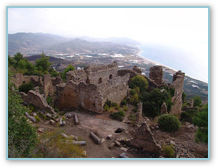 Located on 20 km east of Alanya. As a result of the excavations carried out by Alanya Museum, it is believed that the history of the city dates back to 7th century B.C. The city is surrounded by city walls. There are several cisterns which provided water needs of the city. The nish caved into the stone in one of the caves are decorated with frescoes. The cave must have been used for religious purposes. And is known as baptising cave. There is a wonderful bath building on the east of the town. There are mosaics on some part of the bath floor. Just on the west of the bath, in north-south direction the columned street of the town lies. There are nishes on the north walls of the street. In the excavations it was understood that the street is in 250*10 metres sizes and covered with wooden roof and south is open. There are many inscriptions about races and competition. Other important structures in the town include temple, theatre, acropolis, necropolis, agora, houses and town walls. The inscription which was prepared from Roman emperor Septimus Severus's letter sent to the city in 194 A.D. is exhibited in Alanya Museum. In his letter the emperor expresses his gratefulness to the people of Syedra who resist the bandits and undevaut attacking the city. Entrance to the site is free. It is necesarry to walk 1 km. after the motorway finishes. Going up the hill through the scrubby land, one can see the beauty of Maditerranean and Alanya fortress.
Located on 20 km east of Alanya. As a result of the excavations carried out by Alanya Museum, it is believed that the history of the city dates back to 7th century B.C. The city is surrounded by city walls. There are several cisterns which provided water needs of the city. The nish caved into the stone in one of the caves are decorated with frescoes. The cave must have been used for religious purposes. And is known as baptising cave. There is a wonderful bath building on the east of the town. There are mosaics on some part of the bath floor. Just on the west of the bath, in north-south direction the columned street of the town lies. There are nishes on the north walls of the street. In the excavations it was understood that the street is in 250*10 metres sizes and covered with wooden roof and south is open. There are many inscriptions about races and competition. Other important structures in the town include temple, theatre, acropolis, necropolis, agora, houses and town walls. The inscription which was prepared from Roman emperor Septimus Severus's letter sent to the city in 194 A.D. is exhibited in Alanya Museum. In his letter the emperor expresses his gratefulness to the people of Syedra who resist the bandits and undevaut attacking the city. Entrance to the site is free. It is necesarry to walk 1 km. after the motorway finishes. Going up the hill through the scrubby land, one can see the beauty of Maditerranean and Alanya fortress.
Leartes
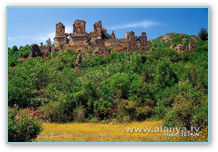 Located about 25 km. away from Alanya, on the skirt of a mountain elevating at the entrance of Dim Valley on Taurus Mountains. The city takes place in the border of the region known as Mountainous Kilikya Region in antique age. Although it spread inland it also has a harbour. Inscription dating the own from B.C. 7th century in Fenike language and found in the town is exhibited in the alanya museum. The important ruins of the town remaining at present are observatory towers, Caracalla excedra, odeon or theatre, Zeus Megistos temple, Apollon temple, Caesar temple, agora, bath and necropolis. According to the inscriptions that are available, this area lived its best period between the first and third centuries. Other important art discovered in the town is 'diploma of a Roman soldier' being exhibited in the Alanya Museum, which gives information about military aspect of the town. The ruins are dated from Roman period. Visit to the site is free.
Located about 25 km. away from Alanya, on the skirt of a mountain elevating at the entrance of Dim Valley on Taurus Mountains. The city takes place in the border of the region known as Mountainous Kilikya Region in antique age. Although it spread inland it also has a harbour. Inscription dating the own from B.C. 7th century in Fenike language and found in the town is exhibited in the alanya museum. The important ruins of the town remaining at present are observatory towers, Caracalla excedra, odeon or theatre, Zeus Megistos temple, Apollon temple, Caesar temple, agora, bath and necropolis. According to the inscriptions that are available, this area lived its best period between the first and third centuries. Other important art discovered in the town is 'diploma of a Roman soldier' being exhibited in the Alanya Museum, which gives information about military aspect of the town. The ruins are dated from Roman period. Visit to the site is free.
lotape
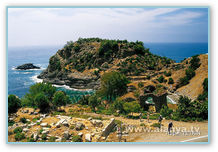 It is 33 km. to the east of Alanya, on the coast. The antique city got its name from Iotape, wife of Antiochus 4 of Kommagene king (A.D. 38-72). The city printed its owner coin during the period from Emperor Trianus to Valerianus. The ruins have features of Roman and Byzantine Period. The acropolis of the city is the high hill extending to the sea. The castle walls gives appearance of castle. The buildings are destroyed considerably. In the valley where acropolis is connected to the land, there is Harbour street extending in east and west direction. On both sides of the street, there are crepis consisting of three steps and fundamentals for sculptures.
It is 33 km. to the east of Alanya, on the coast. The antique city got its name from Iotape, wife of Antiochus 4 of Kommagene king (A.D. 38-72). The city printed its owner coin during the period from Emperor Trianus to Valerianus. The ruins have features of Roman and Byzantine Period. The acropolis of the city is the high hill extending to the sea. The castle walls gives appearance of castle. The buildings are destroyed considerably. In the valley where acropolis is connected to the land, there is Harbour street extending in east and west direction. On both sides of the street, there are crepis consisting of three steps and fundamentals for sculptures.
The written fundamentals of the sculptures contain information about successful athletes and charity loving citizens of the town. In the bay located on east of acropolis there is basilica in rectangular shape with three nephs. There are traces of frescoes inside the small church in the town. In the frest Hagios Georgios Stratelates was figured. Another building still remains in the city is bath. The sewage system of the bath can still be seen. On the modern road passing through the city center there is ruin of a temple in 8*12.5 m. Size. Necropolis of the Iotape is on the north and south hills of the city. Beside monumental tombs there are also small tomb. Structures covered with vaults in the city.Entrance to the ruins is free and it takes about two hours to see around. Small bay with harbour ruins has an ideal beach to have a swim.
Beaches
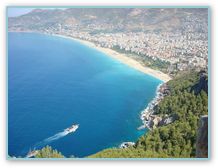 The coast of Alanya consists of wide beaches and they have Blue Flag. Blue Flag is an international practice that determines and inspects the cleanness of the sea water and beach standarts. Blue Flag is to the beaches that conforms with these qualities and it is valid for one year. Every fortnight microbiological and physiochemical analyses of the water is done. In Alanya the colour of the sea turns to turquoise from blue. In still weather it is possible to see the fish deep in the sea. It is common of fish wandering around your feet. The west and east coast of Alanya are beaches. In the west, are Damlataş and Cleopatra beaches and in the east are Keykubat and Portakal beaches. Out of the city, there are come beaches like Ulaş, Konaklı, Fuğla, İncekum, Mahmutlar. Alanya beaches are miles long.
The coast of Alanya consists of wide beaches and they have Blue Flag. Blue Flag is an international practice that determines and inspects the cleanness of the sea water and beach standarts. Blue Flag is to the beaches that conforms with these qualities and it is valid for one year. Every fortnight microbiological and physiochemical analyses of the water is done. In Alanya the colour of the sea turns to turquoise from blue. In still weather it is possible to see the fish deep in the sea. It is common of fish wandering around your feet. The west and east coast of Alanya are beaches. In the west, are Damlataş and Cleopatra beaches and in the east are Keykubat and Portakal beaches. Out of the city, there are come beaches like Ulaş, Konaklı, Fuğla, İncekum, Mahmutlar. Alanya beaches are miles long.
Besides the beaches, there are some natural beaches next to the motorway, under the slope of a hill or among some ancient ruins which awaits its guests who prefer being just with the nature and the history. The rules of local administrations as well as the international ones are applied at the beaches in Alanya city centre. In accordance with these, entrance to the beaches and the showers are free. Deck chairs and beach umbrellas are provided in return of money; however it is not obligatory to seek these service. At buffets in the beaches there are no price difference. At the beaches no boats and water sports vehicles are allowed within a certain distance from the coast; swimming areas are determined with barriers.
Damlataş Beach
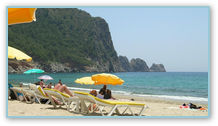 To the west of the historical peninsula, in front of Damlataş Cave. It has a Blue Flag. The sea and the beach is sandy. The beach leans backwards the skirts of peninsula. The small bay of this beach extending to the peninsula and made of stones is called Cleopatra. According to the mythology Egyption Queen Cleopatra, in a voyage in Mediterranean, stopped by in Alanya and had a swim in this bay. The special feature of Cleopatra Bay is that the clearness of its water. People who are looking for a long swimming coarse can swim along the coast to Fosforlu Cave under the peninsula. If you have a goggles you can see the fish and other services due to payment.
To the west of the historical peninsula, in front of Damlataş Cave. It has a Blue Flag. The sea and the beach is sandy. The beach leans backwards the skirts of peninsula. The small bay of this beach extending to the peninsula and made of stones is called Cleopatra. According to the mythology Egyption Queen Cleopatra, in a voyage in Mediterranean, stopped by in Alanya and had a swim in this bay. The special feature of Cleopatra Bay is that the clearness of its water. People who are looking for a long swimming coarse can swim along the coast to Fosforlu Cave under the peninsula. If you have a goggles you can see the fish and other services due to payment.
Cleopatra Beach
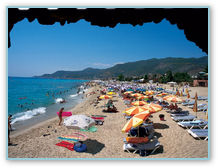 A part of Damlataş Beach, it is about 2 km long. It has a Blue Flag. Its sea and beach is sandy. It has a wide beach. The depth of the sea reaches height of a man after 3-4 steps. It is the most popular beach of Alanya; in summer thousands of people come here. In some parts behind the beach are sports fields, parks, hotels and cafes. Along the beach are some water sport enterprises such as parachute, jet ski, sea bicycle, etc; entertainment water sports activities are done beyond swimming area. Entrance is free; deck chairs, umbrellas are due to payment. About every 50 metres you can a refresment stall; in refreshment stalls fast food and drinks are available. Sunset creates a beautiful view here in this beach.
A part of Damlataş Beach, it is about 2 km long. It has a Blue Flag. Its sea and beach is sandy. It has a wide beach. The depth of the sea reaches height of a man after 3-4 steps. It is the most popular beach of Alanya; in summer thousands of people come here. In some parts behind the beach are sports fields, parks, hotels and cafes. Along the beach are some water sport enterprises such as parachute, jet ski, sea bicycle, etc; entertainment water sports activities are done beyond swimming area. Entrance is free; deck chairs, umbrellas are due to payment. About every 50 metres you can a refresment stall; in refreshment stalls fast food and drinks are available. Sunset creates a beautiful view here in this beach.
Keykubat Beach
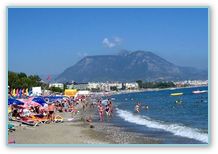 Situated to the east of the peninsula, it is 3 km long starting from the Municipality building and on. It owns a Blue Flag. The sea and the beach is sandy, there are some sand rocks in some parts. Because of the parks and gren area of the hotels along the beach, it is also called Begonvil Beach. Like Cleopatra, this is also a popular beach. In the coast you can find all kinds of water sports activities. Entrance is free; beach services are due to payment. Deck chairs, umbrellas can be found from the refreshment stalls located in every 50 metres. The restaurants and cafes of the hotels also welcome people coming. You can go on a boat trip from the quays of some of the hotels.
Situated to the east of the peninsula, it is 3 km long starting from the Municipality building and on. It owns a Blue Flag. The sea and the beach is sandy, there are some sand rocks in some parts. Because of the parks and gren area of the hotels along the beach, it is also called Begonvil Beach. Like Cleopatra, this is also a popular beach. In the coast you can find all kinds of water sports activities. Entrance is free; beach services are due to payment. Deck chairs, umbrellas can be found from the refreshment stalls located in every 50 metres. The restaurants and cafes of the hotels also welcome people coming. You can go on a boat trip from the quays of some of the hotels.
Mahmutlar Beach
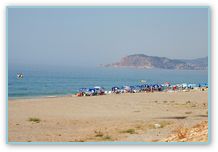 In about 16 km east of Alanya. The sea and the beach is sandy, in some parts sand rock. Some parts of the coast that is about 5 km. are natural beaches. In the parts where there are refreshment stalls, deck chairs and umbrellas are available. Entrance is free. Mahmutlar coast is on Alanya-Gazipaşa road and there are public buses to the area all day long.
In about 16 km east of Alanya. The sea and the beach is sandy, in some parts sand rock. Some parts of the coast that is about 5 km. are natural beaches. In the parts where there are refreshment stalls, deck chairs and umbrellas are available. Entrance is free. Mahmutlar coast is on Alanya-Gazipaşa road and there are public buses to the area all day long.
Caves
It is possible to call alanya 'a city of caves' You can discover the mysterious world of land and sea caves in Alanya. While wandering about the fascinating world of land and sea caves in Alanya. While wandering about the fascinating world of stalactites and stalagmites formed in thousands of years in land caves, you will also witness the forming of new stalactites and stalagmites. This witness, with the scenery created by the lighting inside the cave, will take you into a fantasy film. The world famous cave of Alanya is Damlataş Cave. The air in Damlataş is beneficial to the patients of asthma and doctors advise their patients o visit this cave. Kadıini Cave, which is not open for visit yet, is the settlement for the people of alanya 20 thousand years ago. Also the sea caves down under the peninsula are the places where ancient mythological tories took place.
Damlataş Cave
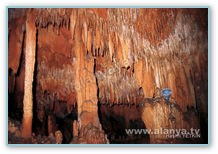 Damlataş Cave was discovered in 1948 quite by accident while minig for building of the harbour. It is located at the western foot of hold peninsula. There is a 50 m passage at the entrance. After the passage there comes a cylinderical cavity. This leads to the basement of the cave. The stalactite and stalagmites inside the cave were formed in 15 thousand years. Besides its fascinating beauty the cave is famous with its air which is beneficial to asthmatic patients. Following the rumors that asthmatic benefited from breathing the air in the cave, scientists analyzed a sample of the air to verify the fact that the air was indeed beneficial to patients suffering from non-allergic asthme. They found that the air in the cave contains 10 to 12 times more carbon dioxide than normal air and has % 95 humidity. Temperature in the cave is 22 degrees centigrade. Both the radioactivity and ionization in the cave may contribute to the benefits derived from breathing the air in the cave. Entrance is due to payment. There is a small market around and in front of the cave is a beach.
Damlataş Cave was discovered in 1948 quite by accident while minig for building of the harbour. It is located at the western foot of hold peninsula. There is a 50 m passage at the entrance. After the passage there comes a cylinderical cavity. This leads to the basement of the cave. The stalactite and stalagmites inside the cave were formed in 15 thousand years. Besides its fascinating beauty the cave is famous with its air which is beneficial to asthmatic patients. Following the rumors that asthmatic benefited from breathing the air in the cave, scientists analyzed a sample of the air to verify the fact that the air was indeed beneficial to patients suffering from non-allergic asthme. They found that the air in the cave contains 10 to 12 times more carbon dioxide than normal air and has % 95 humidity. Temperature in the cave is 22 degrees centigrade. Both the radioactivity and ionization in the cave may contribute to the benefits derived from breathing the air in the cave. Entrance is due to payment. There is a small market around and in front of the cave is a beach.
Dim Cave
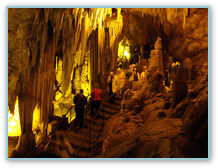 It is located 12 km east of Alanya, on the slope of Cebel-i Reis Mountain of 1,649 metres. It has an altitude of 232 m. The cave is introduced to the visitors in 1998 and it is the second biggest cave known to the visitors. It is estimated to be 1 million years old. There are two paths inside the cave one is of 50 m, the other of 360 metres. There is a small lake towards the and of the cave.
It is located 12 km east of Alanya, on the slope of Cebel-i Reis Mountain of 1,649 metres. It has an altitude of 232 m. The cave is introduced to the visitors in 1998 and it is the second biggest cave known to the visitors. It is estimated to be 1 million years old. There are two paths inside the cave one is of 50 m, the other of 360 metres. There is a small lake towards the and of the cave.
The 360 m. Long path is prepared and illuminated, so as to provide a pleasant excursion offering a tremendous scenery of stalagmite and stallactite for the visitors. After the excursion you can go down the path to Dim Creek valley or you can take the walk up the cave from the picnic area near the creek. There is a panoramic view of Alanya Fortress at the slope where the cave takes place. There are public buses going to the cave. Entrance is due to payment.
Kadiini Cave
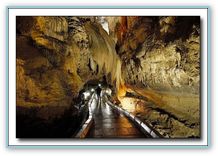 Situated about 15 km north-east of Alanya, at a place called Çatak. There are stalagmites and stalactites three times bigger than the ones in Damlataş Cave. In the researches carried out in 1957 scientists found some human skeletons and fossils. They also found that these foundings belonged to the time of 20 thousands years ago and the first sttlement in alanya had been here. There are picnic areas in the vicinity. The cave has not been introduced to visitors yet.
Situated about 15 km north-east of Alanya, at a place called Çatak. There are stalagmites and stalactites three times bigger than the ones in Damlataş Cave. In the researches carried out in 1957 scientists found some human skeletons and fossils. They also found that these foundings belonged to the time of 20 thousands years ago and the first sttlement in alanya had been here. There are picnic areas in the vicinity. The cave has not been introduced to visitors yet.
Korsanlar Cave
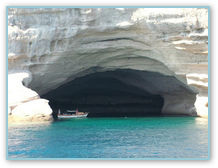 It's a sea cave under the historical peninsula where there is the Alanya Castle. Sea transportation is done by boats. Around the peninsula, according to the tour programmes, it's the first cave. Little boats can enter the cave. You can also swim to enter the cave. There was a rumour that there was a hidden path reaching the castle and the pirates of ancient time took out their booty from this path to the upward part of the castle. The image of the rocks under the sea makes the cave more mysterious.
It's a sea cave under the historical peninsula where there is the Alanya Castle. Sea transportation is done by boats. Around the peninsula, according to the tour programmes, it's the first cave. Little boats can enter the cave. You can also swim to enter the cave. There was a rumour that there was a hidden path reaching the castle and the pirates of ancient time took out their booty from this path to the upward part of the castle. The image of the rocks under the sea makes the cave more mysterious.
Aşıklar Cave
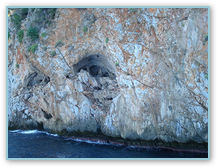 The cave, situated by the side of the historical peninsula, has got two entrances. After the boat comes alongside the rocks towards Cilvarda promontory, it's able to reach the cave by rock climbing. You can reach the low entrance with a few steps. It's 75 m. Long. Since it has a low ceiling, you sometimes bend down while walking.
The cave, situated by the side of the historical peninsula, has got two entrances. After the boat comes alongside the rocks towards Cilvarda promontory, it's able to reach the cave by rock climbing. You can reach the low entrance with a few steps. It's 75 m. Long. Since it has a low ceiling, you sometimes bend down while walking.
The altitude of the entrance on the side of Damlataş Cave from the sea is 8m. And you can jump into the sea here. All that moment the boat turns round Cilvarda promontory, gathers the people from the sea and goes on the excursion. However, there can be some people who don't want to jump into the sea at the last moment and it's more difficult for them to step down the rocks, so what you'll do is at first stuffing up your nose and then diving into the sea with a huge scream. There was a rumour that the pirates hid their booty and girls in this cave. It's thoughtthat the cave was named as Lovers Cave as the couples dated thre secretly.
Fosforlu Cave
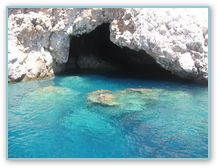 It's a sea cave on the side of Damlataş Cave in the peninsula. Little boats are able to enter the cave. Because of its geological construction the ground shines almost as if phosphorecently at nights due to the reflection of the moonlight. It's also possible to notice the glitter in the daytime. There are also the short swimming breaks in front of the cave as swimming here is an enjoyable experience.
It's a sea cave on the side of Damlataş Cave in the peninsula. Little boats are able to enter the cave. Because of its geological construction the ground shines almost as if phosphorecently at nights due to the reflection of the moonlight. It's also possible to notice the glitter in the daytime. There are also the short swimming breaks in front of the cave as swimming here is an enjoyable experience.
The Taurus Mountains
Although Alanya is on the coast of the Mediterranean, its back rests on Western Taurus. The Taurus Mountains are of essential importance in the life of Alanya people. Going to pasture in the mountains and spending the summer there is a thousand-year's Turkoman tradition. Up until the last century, the villagers used to leave their villages with the coming of spring and go to pasture. On the plains of the Taurus exceeding thousand meters, the tents made of goat hair were pitched and while on one side flocks were put out the pasture on the other side people makes cheese and butter and weave carpets and rugs. The pasturage culture today exists in the luxurious cottages instead of the tents for people to go there and have a cool weekend holiday. The Taurus hold the unique beauty of the nature with its pine and cedar trees covered by forests, deep valleys, peaks in clouds and rivers coming from peaks. Nowadays the pastures are commonly visited by both local and foreign tourists; old Turkmen traditions do still exist in these daily picnic areas.
Dim River
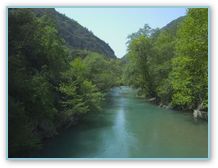 Dim Brook takes its source from the Taurus and flows to the Mediterranean from the east of Alanya; there are picnic areas on the coast of it which is 15 km inside from the coast of the Mediterranean. In summer the tables of field restaurants under the old plane trees are set in the brook. The guests sit there bare feet in the brook. What's more, authentic tables with cushions are set on the wooden terraces on the slopes close to the brook and by the brook. In some restaurants, tables are on the rafts. The valley covered by forests is cool even in the summer. The commonly preferred dish in this area is usually trout. The trout are kept in the pools in restaurant gardens. They are usually fried, cooked in a crock or grilled. Also, there are some sites in the area proper for mountain-biking and trekking.
Dim Brook takes its source from the Taurus and flows to the Mediterranean from the east of Alanya; there are picnic areas on the coast of it which is 15 km inside from the coast of the Mediterranean. In summer the tables of field restaurants under the old plane trees are set in the brook. The guests sit there bare feet in the brook. What's more, authentic tables with cushions are set on the wooden terraces on the slopes close to the brook and by the brook. In some restaurants, tables are on the rafts. The valley covered by forests is cool even in the summer. The commonly preferred dish in this area is usually trout. The trout are kept in the pools in restaurant gardens. They are usually fried, cooked in a crock or grilled. Also, there are some sites in the area proper for mountain-biking and trekking.
Türbelinas Pleteau
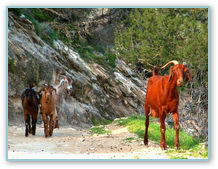 It is on the north east part of the city. It's possible to go there with an hour driving inside the Taurus. Also safari tours by jeep convoys are organised. The road is a bit curved but it is paved with asphalt. It's possible that you see a barber shaving his customer under the old plane trees, and if you wish you can also have a shave in the middle of the street. You can see that drinks are kept in the water troughs instead of fridges to become cooler there. You will feel the pure oxygen in the air filled in your lungs and may wish to take a long walk at that moment. It's recommended that you have 'köy tavuğu' (village chicken) cooked with butter and tomato sauce in the pan that is eaten by dipping your bread in its sauce, as your dish in pasture restaurants. There is Gedevet Pasture, a few kilometres before Türbelinas Pasture and other pastures in the area are Pınarbaşı, Türktaş, Gökbel, Söbüçimen and Mahmutseydi.
It is on the north east part of the city. It's possible to go there with an hour driving inside the Taurus. Also safari tours by jeep convoys are organised. The road is a bit curved but it is paved with asphalt. It's possible that you see a barber shaving his customer under the old plane trees, and if you wish you can also have a shave in the middle of the street. You can see that drinks are kept in the water troughs instead of fridges to become cooler there. You will feel the pure oxygen in the air filled in your lungs and may wish to take a long walk at that moment. It's recommended that you have 'köy tavuğu' (village chicken) cooked with butter and tomato sauce in the pan that is eaten by dipping your bread in its sauce, as your dish in pasture restaurants. There is Gedevet Pasture, a few kilometres before Türbelinas Pasture and other pastures in the area are Pınarbaşı, Türktaş, Gökbel, Söbüçimen and Mahmutseydi.
Dereköy Plateau
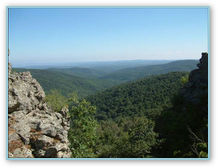 It's a plateau country situated on the side of the valley where Kargı Brook flows in the south of Alanya. It was founded between the pine trees and vegetable fruit gardens. You can go there using the 30 km. asphalt road. The forest is convenient for people to take a picnic and go for a walk. You can do shopping from the country grocer and then drink a stewed tea in the country cafe. There are also country restaurants offering meat dishes.
It's a plateau country situated on the side of the valley where Kargı Brook flows in the south of Alanya. It was founded between the pine trees and vegetable fruit gardens. You can go there using the 30 km. asphalt road. The forest is convenient for people to take a picnic and go for a walk. You can do shopping from the country grocer and then drink a stewed tea in the country cafe. There are also country restaurants offering meat dishes.
Söğüt Plateau
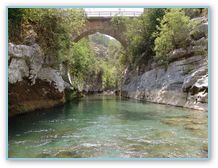 It's located in the inner parts of the Taurus Mountains. You can reach the plateau from the bank of Demirtaş Brook, using a stabilized road where there are citrus fruits gardens, green houses, greengrowths and pine trees. From Demirtaş, Kaş is in 30 km, Sapadere in 35 km, Tokar in 40 km and Söğüt Pasture in 50 km. There are country cafes and restaurants in plateau countries.
It's located in the inner parts of the Taurus Mountains. You can reach the plateau from the bank of Demirtaş Brook, using a stabilized road where there are citrus fruits gardens, green houses, greengrowths and pine trees. From Demirtaş, Kaş is in 30 km, Sapadere in 35 km, Tokar in 40 km and Söğüt Pasture in 50 km. There are country cafes and restaurants in plateau countries.
Museums
There are four museums in Alanya. These are the Museum of Archaeology, that of Ethnography, Museum of İçkale and Museum of AtatürkÕs House. All of the museums are under control of the Head Office of Museums in Alanya and you have to pay for a visit. They are all open to visitors during the week except for lunch breaks.
The most important work in Alanya is the statue of Heracleus exhibited in the museum of Archaeology. Kızılkule in the harbour is designed as the museum of Ethnography. İçkale, built as the palace of the Sultan Alaaddin during the reconstruction of the city in the 13th century, is now a museum and open to visitors.
Museum Archaeology
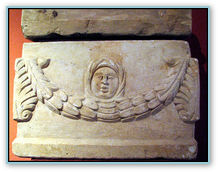 The Museum of Archaeology in Alanya opened in 1967, on the arrival of articles of Bronze Age, and those belonged to Urartu, Frig and Lidya from the Museum of Anatolian Civilization in Ankara. The museum has been enriched with the work found in the excavations that have been carried out recently.
The Museum of Archaeology in Alanya opened in 1967, on the arrival of articles of Bronze Age, and those belonged to Urartu, Frig and Lidya from the Museum of Anatolian Civilization in Ankara. The museum has been enriched with the work found in the excavations that have been carried out recently.
The museum has a part of archeology and a part of ethnography. The oldest article found near Alanya and exhibited in the archaeology clivision of the museum is a stone inscription written in phoenician language and it dates back to 625 BC. The statue of Heracleus, made of bronze and dating back to 2nd century BC is exhibited in another part. There are vast collections of ash boxes and coins in the Museum of Archaeology in Alanya, along with the things found and belonging to the archaic, classical and Byzantine era, the Hellen period and these are made of bronze, marble, fired soil, glass and mosaic. Furthermore, the museum has works of Turkish-Islamic world of Selcuks and Ottomans. In the division of ethnography there are things like carpets of Turkoman nomadic tribes, colourful sacks, saddle-bags, clothes, samples of ornaments, guns, household goods for daily use, accessories, manuscripts and writing sets that have been collected from the surrounding areas and reflecting the folkloric character of the region and a room of a old Alanya house are all exhibited. There are also stone works of Romans, Byzantine and Islamic periods in the garden of the museum. You have to pay for a visit to the museum which is open during the whole week.
Museum of Etnography
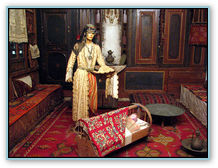 Kızılkule, which is in the harbour and is a work of Selcuks of the 13th century, is at the same time the museum of ethnography. The ground floor and the first floor of the five-storey tower have been designed as museums. In the museum there are carpets, rugs, clothes, household goods, guns, scales, devices of illumination, and looms peculiar to Alanya and ethnographic works like the tent representing the Turkoman nomadic tribe culture in the Taurus Mountains. Sometimes that historical building welcomes cultural or art activities such as exhibitions of painting or classical music concerts. You can catch a view of the panoramic landscape of the eastern part of the city and the way of settlement on the historical peninsula at the top floor of the tower. Moreover, you can go to the walls from the tower and walk feeling history. You have to pay for a visit to Red Tower.
Kızılkule, which is in the harbour and is a work of Selcuks of the 13th century, is at the same time the museum of ethnography. The ground floor and the first floor of the five-storey tower have been designed as museums. In the museum there are carpets, rugs, clothes, household goods, guns, scales, devices of illumination, and looms peculiar to Alanya and ethnographic works like the tent representing the Turkoman nomadic tribe culture in the Taurus Mountains. Sometimes that historical building welcomes cultural or art activities such as exhibitions of painting or classical music concerts. You can catch a view of the panoramic landscape of the eastern part of the city and the way of settlement on the historical peninsula at the top floor of the tower. Moreover, you can go to the walls from the tower and walk feeling history. You have to pay for a visit to Red Tower.
Museum of İçkale
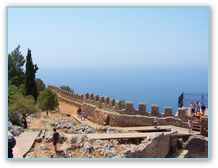 It is in the historical citadel, at the peak of the peninsula lying towards the Mediterranean. The palace of Alaaddin Keykubat, the Sultan of Selcuks was found as the result of the excavations carried out for years. Some excavations are still in progress. There's a little church of Byzantine Period, just opposite the ruins of the palace in İçkale. The church known as the church of Aya Yorgi or of Hagios Georgios is thought to have been built in the 6th century. It is like a clover in shape and the only building that does not belong to Selcuks Period in İçkale, and it can be seen today as a proof of their tolerance for different religions. There are traces of frescos, however rare, on the inner walls of the church. From the part called Seyirlik in İçkale you can see the Taurus Mountains above and the western wing of Alanya below. The cistern on a cliff in İçkale is known as Adam Atacağı. According to a legend, those who were sentenced to death were allowed to throw there pebbles to the sea, otherwise they would be put in a big sack and thrown downwards. The cistern of 15 metres in depth is said to have been a dungeon. Exhibitions of painting take place in one of the halls in İçkale. You have to pay for a visit to İçkale.
It is in the historical citadel, at the peak of the peninsula lying towards the Mediterranean. The palace of Alaaddin Keykubat, the Sultan of Selcuks was found as the result of the excavations carried out for years. Some excavations are still in progress. There's a little church of Byzantine Period, just opposite the ruins of the palace in İçkale. The church known as the church of Aya Yorgi or of Hagios Georgios is thought to have been built in the 6th century. It is like a clover in shape and the only building that does not belong to Selcuks Period in İçkale, and it can be seen today as a proof of their tolerance for different religions. There are traces of frescos, however rare, on the inner walls of the church. From the part called Seyirlik in İçkale you can see the Taurus Mountains above and the western wing of Alanya below. The cistern on a cliff in İçkale is known as Adam Atacağı. According to a legend, those who were sentenced to death were allowed to throw there pebbles to the sea, otherwise they would be put in a big sack and thrown downwards. The cistern of 15 metres in depth is said to have been a dungeon. Exhibitions of painting take place in one of the halls in İçkale. You have to pay for a visit to İçkale.
Museum of Atatürk's House
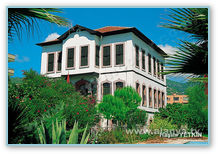 This is the house where Mustafa Kemal Atatürk, the founder of Turkish Republic stayed for a while when he visited Alanya on 18 February 1935. The owner of the house, Mr. Rıfat Azakoğlu left it to Ministry of Culture to be preserved as a museum. The three-storey building situated in a garden reflcts the 19th century Turkish architecture. In the ground floor, Atatürk's personal belongings, photographs, the telegram that Atatürk sent to people of Alanya and some other historical documents are exhibited. The rooms upstairs are decorated with some traditional furniture.
This is the house where Mustafa Kemal Atatürk, the founder of Turkish Republic stayed for a while when he visited Alanya on 18 February 1935. The owner of the house, Mr. Rıfat Azakoğlu left it to Ministry of Culture to be preserved as a museum. The three-storey building situated in a garden reflcts the 19th century Turkish architecture. In the ground floor, Atatürk's personal belongings, photographs, the telegram that Atatürk sent to people of Alanya and some other historical documents are exhibited. The rooms upstairs are decorated with some traditional furniture.



























